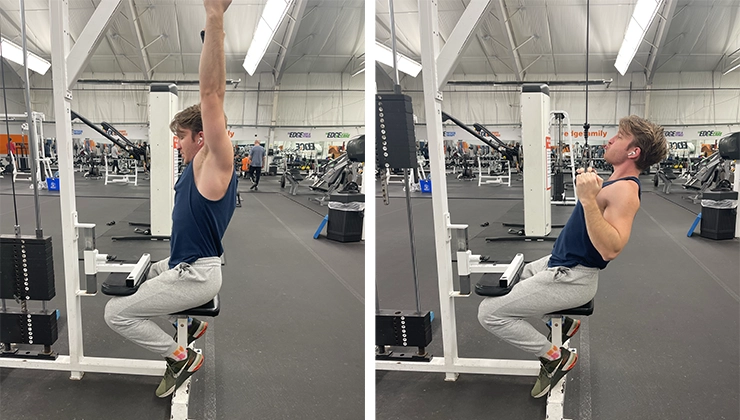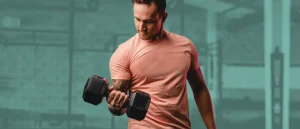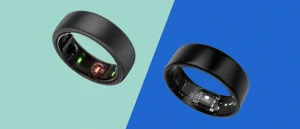This Pulldown Variation Will Blow Up Your Back (Without the Shoulder and Wrist Pain)
- By Will Price
- Reviewd by Sydney Bueckert, NASM CPT, CES, FNS, GPT
- November 29, 2023
Fast Facts
- Neutral grip lat pulldowns are excellent for anyone that deals with shoulder, elbow, or wrist pain during typical pulldown exercises
- Neutral grips are grips which are held with the hands facing inward, toward one another
- Neutral grip lat pulldowns work more or less the same muscles as traditional lat pulldowns
After the deadlift and bent-over row, there’s no more classic back-building workout than the pulldown. It’s simple, it nails your lats, and it’s fairly easy to put a lot of weight on the stack with it—this is a recipe for an effective and fun workout.
That said, every gym goer’s body is different, and many struggle with grip strength, wrist pain, or shoulder discomfort (sometimes all at once). The neutral grip lat pulldown—which simply shifts the angle of your wrists from pronated, or facing forward, to neutral, or angled inward—is for those lifters.
Here’s everything you need to know.
Our Experience
Hone Health is a team of health-obsessed journalists, editors, fitness junkies, medical reviewers, and product testers. I’ve put hundreds of hours into reading through fitness research, speaking with personal trainers, and testing gym equipment (not to mention the years of my life spent in weight rooms). I’ve also dealt with the very discomfort and pains associated with traditional lat pulldowns, and incorporate neutral grip pulldowns into my own routine.
What Is a Neutral Grip Lat Pulldown?
A neutral grip lat pulldown is the same movement as a traditional lat pulldown, just with the overhand (AKA pronated) grip swapped out for a neutral grip attachment. A neutral grip is one in which your hands are fixed perpendicular to your shoulders—or, in other words, facing one another.
Neutral grips come in as much variety as overhand grips—close V-grips, medium-width T-bars, wide grip options, and more.
The primary reason lifters switch from overhand (or the more rare underhand) lat pulldowns is comfort. The neutral grip puts less strain on the joints associated with the lat pulldown—the wrist and shoulder joints, mostly—making it easier to hit consistently and apply progressive overload to.
If you’re wondering whether your joints might be holding you back on the lat pulldown, here’s a simple experiment:
Hold your arms bent in the finishing position of a pulldown—arms bent to about 60 degrees, elbows around your midsection—and slowly turn your wrists from pronated (pointing forward) to supinated (pointing backward). Which wrist position tenses your wrists, forearms, and shoulders? Which feels best? If you feel relief in that middle position—the neutral grip—a neutral grip pulldown is worth experimenting with.

Neutral Grip Lat Pulldown Benefits (Why Neutral Grip Pulldowns?)
Wrist and shoulder comfort
There are dozens of reasons for your wrists or shoulders to feel tight or uncomfortable during a normal lat pulldown, but the reality is, for many lifters, a neutral grip is simply more comfortable. Comfort translates to more weight, sets, reps, and progress—all of which create more muscle and strength, which is the point of lifting weights in the first place.
Less limited by grip strength
Though literally all weight training is, to some extent, limited by grip strength, a movement that adds tension to the wrist before the exercise has even begun will certainly limit it to a greater extent. This is important because, when performing isolation exercises like the lat pulldown, we want our failure point to be determined by the muscles running out of gas, not our ability to grip the bar (though you should absolutely train grip strength separately, too).
Thus, because the neutral grip pulldown makes it marginally easier to grip the pulldown attachment, it might allow you to grind out another rep or two, or add that little extra weight to progress.
Builds a powerful back
Despite all this talk about grips and pronation and joint discomfort, all lat pulldowns build bigger, more powerful back muscles. Pulldowns are among the most effective stimulators of the lats, which is the largest group of muscles in the back.

Muscles Worked by Neutral Grip Lat Pulldown
Neutral grip lat pulldowns target the lats, but a complete list of muscles recruited for the movement looks like this: lats, traps, teres, biceps, rhomboids, and rear delts. Here’s how they all come into play.
Lats (Latissimus dorsi)
If you’re doing it right, the lats are the primary weight mover in a lat pulldown. The lats make up a large portion of the middle and lower back, and are to varying degrees responsible for a majority of pulling tasks (opening doors, picking up something off the floor, etc.).
Traps (Trapezius)
The traps are known as a showy muscle because people with big traps just look big—think of Bane, the villain in The Dark Knight Rises, for reference. The muscle group balances the shoulders, stabilizes the spine, and helps you move your head and neck around.
During a neutral grip lat pulldown, they play their typical role but can take over more than wanted if you’re not careful (especially on close-grip setups). Remind yourself to pull with your lats—a common cue to keep you on the right track is to pull your elbows into your pockets.
Teres (Teres major and minor)
Think of the teres muscles as your lats’ assistant. It’s located just above the lat, riding the side of your scapula. It helps with shoulder movement and, generally speaking, any lat-focused movement will also work your teres major.
Biceps
After shoulder or wrist discomfort, one of the most frequently asked questions about the lat pulldown is about bicep involvement, and it’s usually worded like this: why do I feel the lat pulldown in my biceps instead of my lats?
Your biceps are the primary force generator for any elbow flexion, which happens in the second half of the lat pulldown movement, so bicep involvement is inevitable and totally normal. The more lat pulldowns you do, the more you’ll develop the mind-muscle connection between your brain and your lats, and thus the more you’ll “feel” them during the movement.
Rhomboids
If the teres muscles are your lats’ assistants, your rhomboids are the trapezius assistants. They’re located under the traps, and they help perform many of the same tasks associated with the traps: shoulder stability, head movement, arm movement, and so on.
Rear delts (Posterior deltoids)
If your arm is moving backwards, your rear delts are doing some work. Rear delts sit on the backside of your shoulders.
Best Neutral Grip Lat Pulldown Attachments












